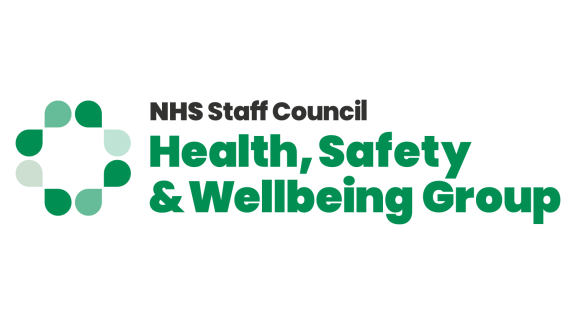
About the Health, Safety and Wellbeing Group
The Health, Safety and Wellbeing Group (HSWG) is a sub-group of the NHS Staff Council. It is a tripartite group involving staff side representatives from healthcare unions, management side representatives from NHS organisations and specialist members, such as the Health and Safety Executive, and the Institute of Occupational Safety and Health with a remit to do the following:
- to raise standards of workplace health, safety, and wellbeing in healthcare organisations
- to promote a safer working environment for all healthcare staff
- to promote best practice across both the NHS and the Independent sector.

This guidance was produced through partnership working between unions, management and specialist advisors. The group wishes to ensure this guidance is implemented with the same partnership approach. HSWG recognises that partnership working ensures best outcomes for patients and staff in protecting their health, safety and wellbeing.
Find further HSWG resources to support you in your organisation.
- Download this chapter
- About the Health, Safety and Wellbeing Group
Key aims of this resource
- To advise managers on their role in preventing musculoskeletal disorders (MSDs, may also be known as MSKs) and supporting staff who have pre-existing MSDs.
- To inform employees how they can promote, protect and support their musculoskeletal health to provide a basic framework and direction on where to get more detailed advice on the complex issues which arise in the healthcare setting.
- To provide guidance to a range of professionals, including health and safety, occupational health, ergonomists, and back care professionals as well as managers involved in risk management of MSDs.
- To support managers and safety representatives to work together to prevent musculoskeletal disorders and ensure employees do not suffer ill health or injury as a consequence of their work.
- It is not intended to be a comprehensive guide for managers on dealing with the complicated issues surrounding back pain and musculoskeletal disorders.
- Download this chapter
- Key aims of this resource
The importance of musculoskeletal health
Musculoskeletal health refers to bones, cartilage, ligaments, tendons and connective tissues. Together with the skeleton, they create a framework and support the body’s weight, maintain posture and help people move.
Musculoskeletal conditions significantly limit mobility and dexterity, leading to early retirement from work, lower levels of well-being and reduced ability to participate in society.
Musculoskeletal conditions can affect people at any age. Prevention, early detection and treatment can support people to remain in good health, stay independent and continue to work. For staff who already have a musculoskeletal disorder, reasonable adjustments can help reduce the risk of worsening a disorder and ensure they can stay in work.
There were an estimated 68,000 work-related cases of musculoskeletal disorders (new or long-standing), which constitutes 22 per cent of all ill health in the human health and social work activities sector.
Across all industries, there are 7.3 million working days lost due to work-related musculoskeletal disorders in 2021/22.
Risks are not just associated with roles that involve patient handling, but are present for a broad range of roles where manual handling forms part of the role.
- Download this chapter
- The importance of musculoskeletal health
Musculoskeletal disorders and the body
The parts of the body most likely to be affected by MSDs are:
- The lower back - Poorly planned moving and lifting work tasks can cause back pain and aggravate existing pain.
- Shoulders, forearms, wrists and hands, as well as the neck - Upper limb disorders include aches and pains in the shoulders, arms, wrists, hands and fingers, as well as in the neck. They may include conditions such as repetitive strain injury, carpal tunnel syndrome, tendonitis and osteoarthritis.
- The hips, legs, knees, ankles and feet - Lower limb disorders affect the hip, thigh, knee, calf, ankle or foot and include joint and soft tissue problems. They may be caused by work or made worse by work, and may include conditions such as hip and knee osteoarthritis, knee bursitis and knee meniscal lesions/tears.
- Download this chapter
- Musculoskeletal disorders and the body
Legal requirements
Employers must protect staff from the risk of injury and also protect staff who have an existing musculoskeletal disorder from hazardous manual handling in the workplace. Manual handling includes moving or supporting a load by hand or bodily force. It includes lifting, putting down, pushing, pulling, carrying or moving loads. A load can be an object or a person.
The Manual Handling Operations Regulations 1992 and Manual Handling Operations Regulations (Northern Ireland) 1992 place a duty on all employers to follow the following hierarchy of measures:
- Avoid hazardous manual handling operations ‘so far as is reasonably practicable’, by redesigning the task to avoid moving the load or by automating or mechanising the process.
- Make a suitable and sufficient assessment of the risk of injury from any hazardous manual handling operations that cannot be avoided.
- Reduce the risk of injury from those operations ‘so far as is reasonably practicable’. Where possible, provide mechanical assistance, for example a sack trolley or hoist. Where this is not reasonably practicable, explore changes to the task, the load and the working environment.
Specific guidance on the regulations is available on the HSE and HSE NI websites, together with full risk assessment checklists, manual handling toolkit and further information on preventing musculoskeletal disorders.
Employers should ensure that in addition to assessing and managing risks resulting from manual handling tasks and activities, individual risk assessments of staff are undertaken to identify whether specific adjustments suited to the individual are required. These may include reasonable adjustments, tailored adjustments or phased returns.
Reasonable adjustments
Employers must make reasonable adjustments to ensure workers with disabilities and physical or mental health conditions are not substantially disadvantaged when doing their jobs. This applies to all workers, including trainees, apprentices, contract workers and business partners. There’s more detail about employers’ obligations and how to meet them on the Equality and Human Rights Commission website.
In addition to regulatory compliance, employers must consider the moral obligation they have to protect staff, ensure they do not suffer injury or ill health at work, and support them if they have musculoskeletal problems to enable them to stay in work.
- Download this chapter
- Legal requirements
Ergonomic/human factors approach to manual handling
When considering risks arising from manual handling activities, it is important to ensure that an ergonomics/human factors (E/HF) approach is applied to the job or task design.
Ergonomics has been defined as:
“the scientific discipline concerned with the understanding of interactions among humans and other elements of a system, and the profession that applies theory, principles, data and methods to design in order to optimise human well-being and overall system performance.” International Ergonomics Association (2020)
Key elements of ergonomics/human factors include:
- Adopting a person-centred approach to everything that people need to interact with. This includes their environment, the systems they need to work within and how they affect themselves and others, the tasks they need to carry out and the equipment they are provided with to use.
- Consideration of all factors affecting staff and patient health and wellbeing and the services they deliver. These include individual physical and psychological factors (what they are able to do and how they think), factors within the organisation (structure, priorities and culture) and factors associated with equipment (design, integrity, usability).
- Applying the approach to all circumstances and scenarios.
All of these are important, as they work together to ensure a holistic approach with the aim of achieving the best levels of health and wellbeing for individuals and teams, thereby also enhancing the potential for optimal performance and outcomes in people’s roles and reducing the likelihood of errors.
Within manual handling tasks and particularly patient handling, people must interact with all of the factors to achieve successful outcomes. When people are put into the mix, the belief of what the systems and processes will achieve may not be what will happen in reality. Work as expected and work as done may be at odds. Individuals are all different. These differences may be physical, or psychological, related to knowledge and understanding, their experience, or to their social and domestic circumstances. These can all impact on how they interact with systems, processes and their environment, for good or bad.
A task refers to a goal-directed human activity, i.e., something people do in order to achieve a goal. Within manual handling, this could range from frequently carrying a laptop bag through to safely moving a seriously ill patient.
A task has a clearly defined goal as well as a start and an endpoint. A task may consist of a series of actions which would normally start with a high-level task being broken down into sub-tasks. Some tasks can be predominantly physical in nature and actions being undertaken can be observed. An example of a physical task could be assisting a patient to stand. Other tasks can have a predominantly cognitive aspect which cannot be easily observed to understand what is going on. There are also tasks that require to be completed by a team, therefore a level of collaboration is required. An example of this is patient hoisting. The type of task will determine which task analysis approaches might be more suitable than others.
Before undertaking a manual handling task, it is important that the activity is developed to determine the safest method for those involved. The risk assessment should be done by individuals who have a good understanding of the physical demands of the task and the factors that influence those demands, knowledge of the work process, knowledge of equipment uses and limitations and are trained in risk assessment methods.
- Download this chapter
- Ergonomic/human factors approach to manual handling
Risk management - a continual process
Assessing and managing risks
Manual handling should be avoided where possible. This can be achieved by:
- redesigning the task to avoid moving the load.
- automating or mechanising the process.
When manual handling tasks cannot be avoided, risk assessments must be completed to assess and reduce the risk of injury so far as is reasonably practicable. The assessment should consider the task, the load, the working environment and individual capability. It is important to choose the right level of assessment for each manual handling task, and the simple filters help to identify low-risk tasks from tasks that need more detailed risk assessment.
Managers should also ensure individual risk assessments are undertaken for staff which take into consideration any factors that may increase their risk of injury from manual handling and any existing musculoskeletal disorders to prevent them from worsening.
Managers who complete risk assessments must be suitably and sufficiently trained and competent to do so. They may need to seek further advice and assistance from a health and safety advisor, back care or manual handling advisor when carrying out a risk assessment. Risk assessments should take into consideration vulnerable workers. Managers should ensure that employees and safety reps are consulted as part of the development of risk assessments.
HSE guidance on the manual handling regulations provides more detailed information on the specific assessment that may be required, including:
- Simple filters to distinguish low-risk tasks from tasks which require more detail.
- The manual handling assessment charts (MAC tool) or risk assessment of pushing and pulling (RAPP tool). The MAC and RAPP tools are designed to help users understand, interpret and categorise the level of risk using numerical and colour-coded scoring, similar to a traffic light system, to highlight high-risk manual handling tasks.
- A full risk assessment template.
In addition, where tasks/activities may be repetitive, the ‘Assessment of Repetitive Tasks (ART) tool’ can help assess tasks involving the upper limbs.
Staff input is valuable in solving any new or job-specific issues. and having a safety representative actively involved throughout the risk assessment process can better ensure effective and safe practices are adopted and supported by staff.
A great example of innovation by a member of staff is the invention of a trolley to assist with their work activities. The trolley was designed and manufactured and now features as a measure to reduce the risk to staff when carrying out their work.
Communicating risk controls
When a risk assessment is complete, one of the most important aspects of implementing it is to communicate the control measures to all staff and other relevant people affected. This may be done by developing a safe operating procedure system of work which is specific to the task being undertaken and using that as the basis for training staff and communicating controls.
Consideration should also be given to employees who operate visual display equipment e.g. sonographers, dentists and others involved in medical/clinical imaging work who are likely to meet the definition of ‘users’ or ‘operators’ within the provisions of the Health and Safety (Display Screen Equipment) Regulations 1992 (as amended in 2002)/The Health and Safety (Display Screen Equipment) Regulations (Northern Ireland) 1992. Specific risk assessments are required to consider the ergonomic set-up of such equipment and the user.
Reviewing controls
It is important to review the controls put in place to ensure they are working. This may be completed at a set frequency. A risk assessment and related procedures should also be reviewed if:
- they may no longer be effective
- there are workplace changes that could lead to new risks such as changes to staff; a process; or the substances or equipment used
- a member of staff reports any concern, accident or near miss.
Any changes should be incorporated into the updated risk assessment and procedures, and communicated to staff.
A full and comprehensive guide to risk assessment can be found on the Health and Safety Executive’s website.
Monitoring health and safety measures
It is important to check that measures put in place to manage risks are effective. This can be achieved by implementing monitoring. Monitoring may be proactive which includes routine inspections of premises, plant and equipment and staff, and body mapping with staff. Reactive monitoring includes investigating accidents and incidents and monitoring cases of ill health and sickness absence. The results of monitoring should be reflected by updating risk assessments, management arrangements and procedures, and communicating information to staff.
Training staff
All staff are required to complete the mandatory manual handling training provided by their employer which is relevant for their role as soon as they start work. There are some examples of good practice schemes which support employers to improve standards and consistency. These include:
- Enable organisations to meet the legislative requirements under the Manual Handling Operations Regulations 1992 (as amended 2002)/The Manual Handling Operations Regulations (Northern Ireland) 1992 and the Management of Health & Safety at Work Regulations 1999 (as amended 2003 & 2006)/ The Management of Health and Safety at Work Regulations (NI) 2000.
- Support a seamless approach allowing staff to transfer their skills across NHS Wales.
- The Scottish Manual Handling Passport Scheme (SMHPS) - an initiative designed to improve the standard and consistency of manual handling training/education and the systems (process/procedures) that underpin it within Health Boards and Local Authorities (LA) in Scotland.
- Download this chapter
- Risk management - a continual process
Moving and handling of patients
No one working in a hospital, nursing home, social care, community or emergency services should need to put their personal safety at risk when moving or handling patients. Hoists, sliding aids, electric profiling beds, other specialised equipment and correct safe handling techniques mean staff should no longer have to risk injury while doing their job. However, poor manual handling and poor ergonomic practices still continue to take their toll on the health of NHS staff.
The HSE reports that in human health and social work activities, there were an estimated 68,000 work-related cases of musculoskeletal disorder (new or long-standing), which constitutes 22 per cent of all ill health in this sector.
Patients should be encouraged and allowed to move independently and contribute to the movement where assessed as able. The manual handling of patients should only commence once a suitable and sufficient risk assessment has been carried out, and any appropriate equipment is in place and used in line with the individual’s care plan. It is important that staff are competent and confident in patient handling techniques and have been suitably and sufficiently trained to use the equipment provided.
The organisation's patient handling policy must include a commitment to use safer principles and to reduce manual handling and the associated risk of injury as far as possible. Risk assessments should be based on balanced decision-making to meet the needs of the patient and protect the patient and staff from risk. Blanket policies for manual handling do not address the complex issues involved in moving people.
The key message is that much of the time, manual handling of patients can be avoided through the provision and use of a variety of lifting equipment, handling aids and sound design of hospitals and care facilities. The same message applies to manual handling by other groups including kitchen staff, porters and administrative or clerical staff.
It is important to ensure that any equipment provided for manual handling activities are regularly checked, prior to use for example, maintained and where required, inspected/examined in line with regulatory requirements. For example, hoists used to move people must be examined a minimum of every six months in line with the Lifting Operations and Lifting Equipment Regulations 1998 (LOLER) and the Lifting Operations and Lifting Equipment Regulations (Northern Ireland) 1999.
The Guide to the Handling of People contains further advice and guidance on people handling and assessment. National Back Exchange also offers professional publications and leaflets.
- Download this chapter
- Moving and handling of patients
Bariatric patients
Obesity in the population poses a unique challenge for NHS staff in terms of rehabilitation services. This is especially the case with regard to adequate provision of manual handling equipment.
Plus-size people can have a wide variety of body shapes in addition to differences in BMI. Two people may weigh the same, however, how their weight is distributed may be completely different. Body shapes are based on waist-to-hip ratio and are commonly classified into categories. Each body shape poses its own functional challenges in relation to transfers, mobility and equipment selection.
Definitions
"The term Bariatric is used to describe the field of medicine that focuses on the causes, prevention, treatment and management of obesity and its associated diseases.” Mosby's Medical Dictionary (2016)
- Body Mass Index = BMI – measures body fat based on height and weight.
- Obese = BMI greater than 30 to less than 40.
- Morbidly obese = BMI of 40kg/m2, or the individual being 45kg over ideal weight.
- Bariatric Patient = someone who weighs in excess of 160kgs (25 stone) and has limitations in health and social care due to their weight, physical size, health, morbidity, tissue viability and access to their own environment.
To ensure staff’s health and safety is not compromised, managers should review their manual handling policies, procedures, practices, adequacy of equipment and staff training when treating bariatric patients.
The Health and Safety Executive (HSE) released a detailed research report, with findings revealing that 40 – 70 per cent of NHS Trusts do not have a bariatric policy. These are needed to lead the process for the planning, assessment and management of manual handling risks, including the number of staff, provision of appropriate equipment and intra and inter-agency communication. Spatial risk factors were identified, and it was also revealed that over half of the trusts that did have policies had not looked at the requirement for adequate space.
The HSE report contains the following recommendations for future bariatric strategies:
- strategic policies need to be formulated to equip the NHS for the rapidly growing obese population in England.
- operational policies are needed to lead the process of planning, assessment and management of the manual handling risks for the care and treatment of bariatric patients.
- buildings and vehicles need to be designed to accommodate bariatric patients in safety and comfort and with dignity.
- equipment needs to be designed to ‘fit’ a range of bariatric shapes and sizes (using population data).
- training is needed to support the assessment of bariatric patients and the use of specialist manual handling and clinical equipment.
The national back exchange has also produced some standards for moving and handling bariatric patients.
- Download this chapter
- Bariatric patients
Musculoskeletal health for employees
Employees are responsible for supporting measures put in place to protect themselves and others. Specific ways employees can maintain good musculoskeletal health (as outlined in MSK Aware CIC) include:
Staff experiencing back pain
Most people will have back pain at some time in their lives. Usually, this is not due to anything serious and settles within a matter of days or weeks. Many people manage the problem themselves without seeing their doctor. For those who are worried about the extent of their problem or whose pain persists and gets worse, a visit to a GP is advisable.
In the past, the accepted response to back pain and some types of MSDs was bed rest or keeping the affected part immobile; however, evidence shows it is much better to keep as ‘normally active’ as possible. Avoiding movement slows recovery and can lead to long-term pain. The charity BackCare has some advice on its website to help individuals with the self-management of back pain.
There will be instances where certain types of injury will require medical treatment. If you are in any doubt, you should contact your occupational health unit or your GP.
Keeping up to date with the latest training techniques for manual handling and taking the opportunity to participate in refresher training courses is always good practice. There is also a requirement for your manager to release you for any training related to moving and manual handling and to maintain any equipment in safe working order.
Encouraging patients to help themselves wherever possible and when safe for them to do so is better for them, in terms of encouraging their mobility, and you, in terms of lessening the risk of injury.
Individual capability to safely perform manual handling tasks is important. If you cannot perform manoeuvres using the correct postures and movements for example, due to an underlying condition, an injury, are pregnant or are overweight, this can put you and the patient at risk of injury. A mismatch between physical capability and the demands of the job can lead to increased sickness absence, early ill health retirement and infirmity, if not resolved. Everyone has a responsibility to manage their health and physical fitness.
Maintaining a healthy weight will help you manage back pain and other MSDs, carry out manual handling tasks safely, and make an early recovery from injury.
Improving health and fitness can be done in a variety of ways, from simply finding the time to take a 30-minute brisk walk each day to receiving counselling and support on a troubling personal issue. Your weight and fitness plan should be as individual as yourself; take advantage of schemes on offer from your employer, support from occupational health, colleagues, your line manager, GP, friends and family. More information can be obtained from the National Obesity Forum.
It is important to stress that while you should be supported to lose weight and get fit by your employer if that is what you can and want to do, no one should be bullied or harassed because of a weight issue.
- Download this chapter
- Musculoskeletal health for employees
Musculoskeletal health for managers
The aim of this section is to advise managers on their role in preventing musculoskeletal disorders (MSDs) and supporting staff who are experiencing an MSD. It is not intended to be a comprehensive guide for managers in dealing with the complicated issues surrounding back pain and musculoskeletal disorders. It provides a basic framework and direction on where to get more detailed advice on the complex issues which arise in the healthcare setting.
It is clear that the role of line managers in early intervention is crucial in ensuring that musculoskeletal risks are managed, keeping staff fit and healthy in work and managing sickness absence and rehabilitation.
The line manager’s role:
- Line managers need to be suitably and sufficiently trained to manage staff and raise their skills so that they can tackle issues such as injury to staff and sickness absence with confidence. Training in return to work interviews, together with general management skills, time management and effective communication training should be part of the induction programme for new managers.
It is the role of line managers to be the first line of support when an employee experiences difficulties which may affect their work and wellbeing. Part of the support they should offer is taking steps to:
- reduce the risk of MSDs through manual handling injuries.
- provide access to, and allow staff to attend, manual handling training courses, including refresher courses.
- encourage the early reporting of any symptoms, ensuring access to suitable treatment where necessary and support if the problem requires a rehabilitation programme.
It is important that managers themselves are adequately trained in relevant moving and handling techniques and assessment so that they can identify unsafe practice and promote good practice among their staff.
Managers should understand the organisation’s health and safety management system (H&S policy and specific management arrangements) and how they translate to their own area of work. This should include:
- manual handing
- display screen equipment and take into consideration hybrid and homeworking
- workplace conditions e.g. temperature, lighting, rest areas
- provision, use and maintenance of work equipment e.g. hoists
- accident and incident reporting and investigation
- working with safety representatives or employee representatives
- risk management
- equality and diversity.
New staff induction
New staff should have their manual handling knowledge and training assessed as part of their induction, which should occur prior to, or shortly after commencing their employment. After the needs analysis has been carried out, a training schedule should then be put in place. It is good practice to individually risk assess new staff or existing employees undertaking a new role as soon as possible by a competent person, as required under the Management of Health and Safety at Work Regulations 1999 (amended 2006)/the Management of Health and Safety at Work Regulations (NI) 2000.
Support for staff with musculoskeletal disorders
To manage musculoskeletal disorders (MSDs) and back pain effectively organisations need to have a suitable policy in place, which is followed, reviewed and updated and made available to all staff. In supporting staff, a line manager needs to ask themselves the following questions:
- Do you encourage your staff and their safety representatives to tell you when problems with their upper body start to develop?
- Do you review your risk assessments when necessary?
- Do you regularly check the accident and incident reports and sickness absence records?
- Are you responding promptly when someone reports upper body pain?
- Do you have information and advice readily available?
- Do you have access to a fast track service such as physiotherapy?
- Do you arrange reasonable adjustments when necessary (rehabilitation and redeployment) to help people stay at work until they are fit to resume their usual job?
- Are you using all available information to identify measures that will enable you to reduce the risks to employees and others?
The HSE suggests seven sets of management processes and practices that contribute to the development of effective workplace rehabilitation programmes. These are:
- Early and timely identification of vulnerable workers through information obtained via such means as recruitment and selection procedures, health checks and medicals, staff appraisals and other performance measures, absence statistics, the maintenance of regular contact with absent workers, return to work interviews and fitness for work assessments.
- Provision of rehabilitation support in the form of medical treatment and the provision of various ‘vocational services’ such as functional evaluations, training, ‘social support’ and workplace adjustments.
- Coordination of the rehabilitation process by the creation of systems that facilitate sufficient communication, discussion and ‘joined up’ action between all potentially relevant factors, human resource staff, safety practitioners, occupational physicians and nurses, psychologists, disability advisers, equal opportunities personnel, trade union and other workplace representatives and external medical personnel.
- Access to worker representation as a means of ensuring that attempts at rehabilitation are made in an environment of openness and trust.
- Establishment of policy frameworks that clearly detail what can and should be done to support the rehabilitation of workers and also make clear who is responsible and accountable for carrying out the various laid down requirements.
- Systematic action, including the provision of required training, to ensure that any laid down policy frameworks are implemented properly and hence do, in practice, influence how particular cases are handled.
- Adoption of mechanisms that enable any weaknesses in the content and operation of established policy frameworks to be identified and addressed.
Monitoring
Any control measures implemented should be monitored to ensure they remain effective. It is important that accident/incident reports are reviewed and analysed to identify any patterns or trends which may suggest that controls are not as effective as they should be. In addition, observation of staff during tasks/activities helps to ensure that the correct techniques and best practice are applied. Any concerns as a result of observations should be discussed with staff to prevent poor practice from continuing.
Body mapping
‘Body mapping’ is an excellent tool for managers and safety representatives to use in identifying musculoskeletal hazards. Sometimes employees can be reluctant to report aches and pains. They may think that they are the only ones suffering and may not want to be identified or singled out. Body mapping with a group of employees doing the same job can help develop an understanding of shared risk factors, give the workforce a voice and help develop practical solutions.
There is nothing difficult about body mapping. A body map is simply a chart showing the front and back view of a body. Participants use pens or stickers to mark the parts of the chart where they feel aches and pains. Where employees are complaining of problems or where there are high levels of moving and handling injuries, a body mapping session is a good way of investigating concerns.
Managing sickness absence, rehabilitation and re-deployment
When managing long-term sickness absence, many employees are unaware of the full extent of the help available to them. Part of the development of a good policy for managing sickness absence, rehabilitation and redeployment is to take a joint approach through discussion and partnership working with staff and their representatives. This ensures that the policy is owned by all parties involved. When considering the process of return to work from long-term sickness absence, line managers, along with human resources, occupational health and the member of staff in question, need to be involved in the process of helping to determine what steps need to be taken. It may be that a period of rehabilitation, reasonable adjustments and phased return to work is required or that re-deployment is the solution for staff that are not able to fully resume their usual duties.
NHS Scotland has a Once for Scotland Attendance Policy in place to encourage attendance and support employees where health issues impact on their ability to be at work. This policy applies to all employees. It also applies to workers such as bank, agency and sessional workers.
The HSE website offers a number of case studies and advice about the management of sickness absence, and general advice for line managers.
Accidents and ill health
Managers and safety representatives should encourage staff to report all incidents (accidents and near misses) and ill health (e.g. repetitive strain injuries, back pain, numbness, swelling, stiffness of joints) to their employer as soon as possible. Reports must be made to HSE/HSENI when employees are diagnosed with specific occupational diseases, where these are likely to have been caused or made worse by their work.
In addition, following an accident, a report is required when an employee is off work or unable to perform their normal work duties for more than seven consecutive days (GB) or three days (Northern Ireland) as a result of their injury. Employers should undertake investigations as appropriate in order to identify the causes and implement preventative actions to reduce the likelihood of reoccurrence and make reasonable work adjustments for individuals where required. Safety representatives may also carry out an inspection of the workplace concerned.
Employers should provide safety representatives with information and data on the number of incidents and trends across departments.
A summary of the line manager’s role:
- A line manager needs to be a good communicator and capable of developing a rapport with their staff. Line managers need to know how to support their staff and crucially where to get support for themselves in difficult or challenging situations.
- A line manager should understand the duties of their staff and the risks tasks they perform could pose to their health and wellbeing. Managers should ensure that appropriate measures to control risks are in place in their work areas. Managers also need to understand their responsibilities and the policies in place which impact their duties.
- A good line manager will ensure that regular contact is maintained with staff when they go on long-term sick leave. Advice should always be sought at an early stage from human resources and the occupational health department/provider when managing individual cases of employee ill health.
- Line managers should be closely involved in the decision-making process relating to specific cases, as well as the development of strategies to counter the operational impact of sickness absence. It is therefore essential to ensure that line managers have the appropriate training in staff management so that they know how to manage sickness absence effectively and return to work issues correctly.
- Download this chapter
- Musculoskeletal health for managers
Musculoskeletal health for employers
Employers have a key role in setting out the framework and providing adequate resources for managing musculoskeletal health in the workplace.
- Download this chapter
- Musculoskeletal health for employers
The role of safety reps
The health and social work sector has the second highest incidence of work-related musculoskeletal and upper limb disorders in Great Britain. The areas of the body reported as most affected are the upper limbs or neck and the back.
Manual handling, repetitive strain injuries or work-related upper limb disorders are key issues that safety representatives can help to tackle in the health and social care sector. Whether representing porters, catering staff, clinical or office-based, staff safety representatives in health and social care are likely to encounter a variety of workplace hazards that can lead to musculoskeletal disorders.
Safety representatives play a vital role in improving health and safety standards in the workplace. Safety reps have an important role in encouraging members in their workplace to follow agreed protocols and procedures to minimise the risk of personal injury or ill health. The proactive and positive engagement of safety representatives in the planning and reviewing of key risk control measures can reduce the incidence of injuries and work-related health in the workforce.
Employer consultation with employees and safety representatives is an important part of building a good health and safety culture and is a duty under regulation 4 of The Safety Representatives and Safety Committee Regulations 1977 (SRSC 1977)/the Safety Representatives and Safety Committee Regulations (Northern Ireland) 1979. Consultation can help strengthen relationships, as employees feel valued, are able to contribute their ideas, raise concerns and discuss issues which can result in improved performance, raise standards, and make the workplace healthier and safer.
Employers should consult and communicate with employees and safety representatives on:
- The introduction of any measure at the workplace which may substantially affect the health and safety of employees e.g. new technology, new equipment, new premises, ways of working (e.g. new shift patterns).
- Information they must give their employees on risks to health and safety, and preventative measures, including information they are already required by other regulations to give their employees e.g. risks identified in risk assessments and the preventative and protective measures, emergency procedures.
- Planning and organising of health and safety training that they must provide.
- Health and safety consequences of new technology being planned for the workplace and if there could be implications for employees' health and safety e.g. new equipment, substances, processes, machinery, etc.
- Arrangements for ensuring access to competent people to help meet employer obligations under health and safety laws, for example, appointing a health and safety manager.
Inspections
Under regulation 5 of the SRSC Regulations, safety representatives are entitled to inspect the workplace or a part of it, if they have given the employer reasonable notice.
It is good practice to have a rolling programme of three-monthly inspections, and for formal inspections to be jointly carried out by safety representatives and the employer. Inspections may be carried out more frequently:
- in agreement with the employer
- where there has been a substantial change in the conditions of work e.g. new equipment or new information has been published by the HSC/HSE/HSENI relevant to the hazards in the workplace
- following notifiable accidents, occurrences and diseases.
Inspections can be themed; for example, manual handling or ergonomic inspections are a good way of preventing injuries by checking whether risk assessments are in place and that the working environment is safe.
Following an inspection, safety representatives should discuss the findings with the employer and identify and record what further action (if any) is required.
Musculoskeletal inspection sample questions
Download our handy checklist of sample questions to help you develop an inspection template for your organisation.

MSK inspection sample questions
Health and safety committee
Most health and social care organisations will have established health and safety committees. However, under regulation nine of the SRSC 1977, if no committee exists, employers must set up a committee within three months following a request by two or more safety representatives.
Membership of the committee should represent the groups of employees in the organisation and the types of hazards and risks faced.
- Download this chapter
- The role of safety reps
Managing absence and rehabilitation
Fit to work
Recent government campaigns have focused on fitness to work and being supported to remain in work wherever possible.
This resource complements these initiatives and aims to provide employees and employers with the information they need to facilitate a return to work for those affected by a musculoskeletal disorder (MSD).
Keeping fit and eating correctly are both key components in helping staff fight infection and injury. Many NHS organisations offer their staff opportunities to stay or get fit through exercise classes, gyms and discount offers for schemes such as cycle to work. Access to these will depend on your trust and the funding available; usually, these types of schemes are organised by human resources, occupational health, improving working lives or health work and wellbeing officers. General fitness is not always a guarantee against injury – a simple lifting exercise wrongly executed, or just bad luck, can result in an employee sustaining an MSD.
Research has shown that without careful management, what could be a short spell of sickness absence can turn into long-term sickness and result in further medical conditions arising. For those with an MSD, a ‘fast track’ referral to physiotherapy or occupational health, and if necessary, a further referral to another health department, could mean an earlier return to work. Employees returning to work may need to perform lighter duties until they have made a full recovery. Research has shown the benefits of staying in work or making an early return to both the employee and the employer. If your organisation does not offer these options, it may be worthwhile discussing your situation directly with your human resources and occupational health departments as well as your line manager and staff representative.
- Download this chapter
- Managing absence and rehabilitation
Watch the webinar
Watch back our full webinar outlining the NHS Staff Council's new musculoskeletal guidance, helping you keep your workforce healthy and safe.
Further resources
- Musculoskeletal health in the workplace webinar recording - HSWG
- Musculoskeletal disorders guidance - HSE
- Managing health and safety at work - HSE
- The Chartered Institute of Ergonomics and Human Factors
- Ergonomics and human factors at work - HSE
- Toolkit for MSDs - HSE
- Musculoskeletal disorders at work - HSE
- MSK Aware
- Back or neck care advice - BackCare
- National Obesity Forum
- Moving and handling in health and social care - HSE
- Occupational diseases - HSE
- RIDDOR - Reporting of Injuries, Diseases and Dangerous Occurrences Regulations 2013
- Manual Handling Operations Regulations 1992 - HSE
- Manual handling assessment charts (MAC) tool
- Risk assessment of pushing and pulling (RAPP) tool
- Assessment of Repetitive Tasks (ART) tool - HSE
- Variable manual handling assessment chart (V-MAC) tool - HSE
- Return to work after long-term absence - CIPD
- IOSH: Hands on - Preventing work-related upper limb disorders
- Download this chapter
- Further resources



